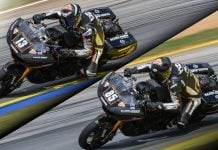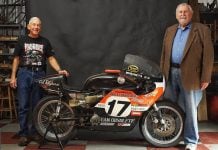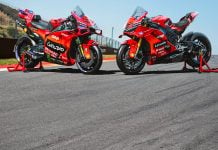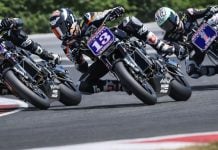Roadracing World: It seems like there are a large number of fans out there who haven’t already read in Roadracing World the reasons why AMA Pro Racing didn’t simply adopt World Superbike rules and carry on. Would you please explain why you didn’t go in that direction? Roger Edmondson: The World Superbike rules are written for the best athletes in the world on teams that have virtually unlimited funding and factory backing. This is just a National Championship here in the United States. I hate to break that to some people, but that’s all it is. And when we consulted with the manufacturers who have been paying the bills and making up the support for this sport, and that has primarily been the four Japanese manufacturers, they did not want World Superbike rules and made it clear. At the same time, they had worked with the AMA before we came on the scene to come up with a rules package that we ultimately adopted with the inclusion of our spec fuel, our spec tires and we took out a few of the more expensive pieces that we thought only added to cost and didn’t add to the racing. So these rules are the rules that the industry asked us to go with and that we compromised with on their part. I was more than happy to run World Superbike rules even though I had concerns that our teams would not be able to afford some of very exotic pieces. RW: Following up on that, there have been a couple of points in the technical rules making process this year where AMA Pro could have gone one direction that would have made it less expensive to build the bikes but it chose to go another direction making it more expensive to build the bikes. One example is fork internal parts homologated for Daytona SportBike. Gas-charged cartridge kits were homologated even though 25mm cartridge kits were used to win the last AMA Supersport race of the 2008 season and cost less than half the price. So why allow in the more expensive parts? Does it add to the racing or just add to the cost? RE: I would say if you ask me, who is a non-technical person, I would say that it only adds to the cost, and I would have to defer that to [AMA Pro Racing Technical Director] Al Ludington and his expertise. I do know that sometimes things that are less expensive on the surface to buy are not less expensive to use. I cannot tell you if this is one of those cases. I frankly don’t know why that decision was taken. As arrogant as I may come across I am not so arrogant to think that I am capable of making the right decision in every case, and I have to defer to my lieutenants in their areas of expertise to make some of those decisions. That was one I didn’t make, but I would be more than happy for you to put that same question to Al and he can answer it for you. RW: And that leads us to the homologation of the Buell 1125RR. Did Erik Buell originally request to homologate just a kit of parts to make the 1125R more competitive in American Superbike? RE: Yes, he did. He sent a list of parts he thought were necessary to get that bike up to speed, and frankly it was a list I couldn’t allow our guys to approve. Then the question came up was there anyway we can take this motorcycle, which we’re currently offering to the public, and make it competitive. And I said, ‘Yes, if you want to put together a race kit and you install it and you’ll support it in terms of selling those same pieces to anybody who wants to buy one and if you’ll race it, yes, we’ll take a look at homologating a complete motorcycle.’ And I’m glad that we did. The only area of concern that I have is I feel the price [$39,995] is a little stronger than where we want to go. A lot of people ask, well, why hasn’t anybody else done that? Nobody else has asked. Buell asked and was given permission, and we relied on the old understanding that has been there for years of what constitutes a certain model of motorcycle. There’s been production motocross and Supercross racing for many, many years, and a long time ago the industry got together with the AMA and they determined that the frame, the swingarm, the head and the engine cases constituted the bike. So once the bike was homologated as a specific model, as long as those pieces remained the same you could then offer kits and other pieces. They had certain availability rules, but the basic homologation was the basis on which everything else took place. That’s the exact same rhyme or reason we used here. RW: It does seem that allowing in this bike as a completely different, race-only model designation that it bends, at best, and at worst breaks the wording of the homologation rule, and more than the wording the spirit of the rule, saying it must be a “street certified” model. Do you think it might have been better if a month ago you reworded the rule before approving this bike? RE: Yeah, probably so. The end result would have been exactly the same, but those who are easily offended would have had something else to argue about instead. This is a non-factor at the end of the day. We need this sport to grow. We need manufacturers who can afford to support it. We need to stop relying on the same four Japanese companies for everything we want out of this sport. Everybody’s robbing that same train, and we have to have a much broader base of support. Yes, perhaps we should have taken a different approach to it, but we didn’t. And I’m still comfortable that the 1125RR is nothing more than a homologated model. It’s still the same motorcycle with the frame, swingarm, cases and heads with a race kit factory-installed and raced by the factory and available to everyone who wants to ante up and buy one. Now, not for use on the street. Once again, none of our racebikes are street-legal anymore, so I don’t know that we’re not splitting hairs when we’re talking about buying one ready-to-race or buying one ready to ride from here to Chattanooga and then having to take all the stuff off of it and put the race kit stuff on it. The end result is the same, and I think we’ve got to take a look at this from a different view point. RW: So what happens now when someone rolls up a 1000cc Inline Four with Öhlins forks, Brembo brake calipers and master cylinder, magnesium wheels, cams and pistons and asks you to homologate it? RE: I tell you what, I would welcome the opportunity to consider those bikes. But again, we’re going to have to take another look internally as to where we want that price point to be. I frankly think I would be much more comfortable if we were under $30,000 on all these bikes. And it may very well be that we will have to ask Buell to increase the efficiency in their process and bring the price of that bike down. But if we could end up with every manufacturer offering motorcycles that they want to race at the factory rider level for sale to every licensed rider and every licensed entrant who wants to enter one and if they will support them with reasonably priced parts and service I don’t know how much better it could get. Instead of having all these people with various capabilities, various access to the right technology and various levels of mechanical expertise out there trying to build bikes that can run with the factories is simply an unrealistic hope on the part of most people. So I would welcome the day when all of manufacturers would have something that you or I could buy and put a top-ranked rider on it and know that we could go racing and let the humans sort it out rather than worrying about whether or not I chose the right subcontractor for pistons or rods. RW: But doesn’t this open up the potential for some sort of arms race where more and more potent racing specials come out of the factories and increase the costs and exclusivity of racing in the American Superbike class? RE: There is if you’re to assume that we are suddenly going to disappear and let them have it as they want to, but remember the bike has to be approved. And we do a very good job of maintaining competition in Grand Am where the cars are very, very different from each other in terms of their powerplant and their handling characteristics. I liken it to equalizing the performance of kumquats and bananas and apples and oranges. It’s a very tight procedure, but that’s the sanctioning body’s job. I’m not saying we would be prepared to let people bring in lightly-disguised MotoGP bikes. Any motorcycle that is presented for homologation the first consideration has to be what will inclusion of this bike do to the competition on the racetrack? And that was the first consideration we had regarding the Buell, and I don’t think anybody out there right now feels we have completely upset the competitive balance of our Superbike field by allowing the Buell 1125RR to compete. And we would no sooner do the same thing with any version Yoshimura or Yamaha might want to present. We’re going to have to look at what its capability is and if we err and we give them too much we can also take away. And by the way, a $30,000 bike is a $30,000 bike. That doesn’t increase the expense in any way shape or form. If we determine that we’re going to put a cap on this even if the manufacturers have to subsidize them somewhat so be it. It’s a completely different era from the $500,000 motorcycles you couldn’t buy at any price a few years ago. RW: If you put similar parts on an Inline Four that the Buell 1125RR has they are going to go faster, probably faster than they are right now. Do you have any concerns on losing control of the speeds of the motorcycles in regards to the level of safety at our racetracks? RE: That’s always been a concern. I’m the one who said back in the old days when 750s [Superbikes] reached their point of no return that the industry would probably go with 600s, and I was foolish enough when we bought AMA Pro Racing to think that now might have been the time to go that direction. And I got a quick education that that was not what the industry wanted, that was not what the fans wanted. And so therefore, being commercially responsible, that’s not what I want anymore either. No, I think we can continue to keep the performance within a certain box in a couple of simple ways that are not so obvious. One of them is the fuel. There’s a certain limit to what you can get out of the gasoline we’re allowing people to use. The second one is the tires. We’re going to be working with our tire partners to determine exactly how aggressively we want these motorcycles to be ridden. And so there’s controls we have there, and once again if we allow somebody to go too far with performance I have no problem with the idea of pulling them back. However, that doesn’t address to your real question, and the real question is our racetracks. John [Ulrich] and your team there at Roadracing World have done a great job at raising money for this Airfence program. We’ve got to work with our tracks and try to identify trouble spots and one by one, if that’s what it takes, try to come up with the money, whether it be with fundraisers or whether it be putting together a pool of all the promoters’ money, and then tracking problems one track at a time. We’ve got to solve those problems. RW: Mat Mladin has been critical of the track safety inspection process. What are your thoughts on the track safety inspection process and who should be involved? RE: Let’s go back to the beginning. The sanctioning body ultimately has to make the decision whether or not to contract with the promoter, and that decision cannot be advocated to by people who are here today and gone tomorrow. You can’t ask a promoter to make the investment that is required to do what needs to be done to their racetrack nor the investment required to hold one of these events without some assurance that they’re investing in something that’s going to be there for years to come. The riders are theoretically a temporary fixture. The facilities themselves and the people who promote the races are theoretically the long-term players. Now somewhere along the line there has to be the ability for the long-term players to get the best advice, the best suggestions from those who are out there risking their lives and putting their butts on the line. No question about that. I do differ on this concept that the people who are fast automatically makes them the most qualified to express what needs to be done or what should be done. And I’m certainly not implying that you can’t be fast and extremely intelligent at the same time. I’m saying that’s not a guaranteed combination. So we tried to get a rider group together that represents some of the younger riders and some of those who have been there for a while. We tried to put together a group that included more than one class because we recognized the 600s have different cornering characteristics to the 1000s. And we put together a small group and went to Heartland Park. We got good advice there. We have a promoter there who is new to the sport who is willing and able to make the investment, and I think everybody is going to be quite pleased in a few days when we get there. Now there may be unanticipated issues that come up. But I have every reason to believe that those people who tried to help us on the Safety Committee were responsible individuals who will make good common sense recommendations that I already know that this promoter is going to listen. That’s the kind of relationships we want to build in the future. I don’t think you have to be a National Champion to make good recommendations. I don’t think National Champions always make good recommendations. We’ve got to work this out together, but it’s clear we have to work together with our athletes. RW: I’m told that the FIM has an actual standard for racetracks. If a corner has this X radius it needs to have this Y amount of run-off room at this vector and this vector and this vector. I don’t think AMA Pro Racing has anything like that. Why don’t you have anything like that? RE: Well, first off, let me tell you where you are correct. Yes, the FIM has a very explicit rulebook that involves the circuits, and it has every one of those things you talked about including track density, length of straightaway, braking areas, run-off room, access roads, everything you can think of is there. And this is absolutely what we have to use as a standard we wish to achieve. So there’s no reason for us to add that book when that book is already out there and we are members of the FIM. The problem is there’s probably only three racetracks in the United States that meet all of those requirements, and I don’t think we could put together much of a series running at Indianapolis, Laguna Seca and Miller Motorsports Park. We’ve got fans in other parts of the country who deserve to have these races. We have people who want to see these races in these parts of the country, and we can’t run, like I said, a three-race series. So what we’ve got to do instead is take those standards and apply them where we can tempered by the fact that it’s all private money in our business. We’re not government subsidized like tracks are in China and other parts of the world, where whatever the FIM thinks up can be accomplished because there’s massive amounts of money available. That’s not the reality of life in our business. Secondly, most of our racetracks were originally designed for automobile racing, because that’s the most profitable item for most of these racetracks. My goal is to change that. I want to see the AMA event become such a huge success that they start having a whole different view of us and our needs and that we get a lot more leverage when it comes to asking for those improvements. But the FIM rulebook is the one we have to go by. RW: I’ve also heard criticism on the timing of these safety inspections at tracks: The timing of when they were inspected, when the recommendations were made, when the recommended modifications were made and then when the follow-up inspections were made in relation to the timing of the event. Some felt it was really tight, as in if it didn’t get accomplished there was no time to do anything about it so why bother having a follow-up inspection 30 days from the race. Do you foresee a set of standards being established for the timing of track homologation inspections in the future? RE: First off, some of that criticism is ill-founded because they don’t know everything we do and when we do it. In terms of the two racetracks that came on board this year to the AMA Nationals, one of them of course is Heartland Park. The first inspection there was made last winter, and we’ve stayed in touch with that promoter and knew very well what he was doing and how he was checking off the things that he agreed to do. So bringing people in not long ago to verify that that work had been done was just a formality and a courtesy on our part. We had an agreement on the part of the riders we took of what they wanted to see. We agreed with the promoter to do it, and he was doing the work and we knew he was doing the work. In the case of New Jersey, we raced Moto-ST there before, and there’s a lot of people with a lot of track time on that track. We were quite confident that the bulk of the facility was going to be acceptable, and it was an easy thing to bring in this test just a few days ago and find if there were any serious things that we hadn’t seen. But we were pretty confident, because this isn’t our first rodeo either, that we were going to be OK at New Jersey, particularly knowing that facility and the management there and what they’ve done to try and work with us at Grand Am. We were the opening event at New Jersey Motorsports Park, and there were a lot of things wrong the day we showed up and there were a lot of things fixed by the time Sunday afternoon rolled around. So there’s no lack of commitment at New Jersey Motorsports Park. But in the future we will once again, if we have new tracks, we will try to work with the committee early on. But I have to tell you, I don’t anticipate too many new tracks coming online now in this economy. I think we’re better off spending our time trying to fix the tracks we’ve got now and making sure we get those guys healthy. RW: I wasn’t at New Jersey for the recent test, but I heard some critical eyes were pointed at the run-off available at Turn One, particularly if a rider had an issue that sent them straight off the track at speed. You said you felt you had a pretty good handle on things there, but when the AMA Pros got there they felt it wasn’t quite up to standard. So what’s happening there? RE: I know that there was some discussion with the track owner. I don’t know that there were any changes that were demanded or required. There’s been some suggestions made, and I think some things considered. But again, let’s go back to fact that these racetracks are used for multiple purposes, and for example if it’s ideal for us on the motorcycle side to have gravel traps they are the bane of the sports car series, particularly when they are on TV. So there’s always a compromise that has to be made, and that’s part of the reason we have the big inventory of Airfence and why we have to pad certain areas because we simply cannot rectify every situation in our current environment in our current economy. When we get to New Jersey Motorsports Park we’re going to have the track set up as safely as we know how. Then it becomes the next issue is the decision each rider has to make for themselves whether or not that they are comfortable participating at that facility. I’m quite confident that we’re gonna have 100% participation at New Jersey. RW: We have a core group of tracks now that most everyone is relatively comfortable racing at, at least in the dry, so why bring on new venues with question marks regarding their safety? RE: I would ask the same question whether we want to grow or whether we want to get smaller, because nothing ever stays the same. If people are satisfied with this sport being the size that it is in terms of sponsor appeal, in terms of spectator appeal, in terms of all the media appeal that we need for television and so forth, then we probably don’t ever need to look at another facility the rest of our lives. But if we expect to attract Fortune 500 companies, and that’s my goal is to somewhere down the road see those sponsor teams out there, teams that are real professional teams not teams running for prize money, teams that are paid to be there, we’ve got to have major markets. Heartland Park covers the middle of the United States in a way that nothing else ever did. New Jersey Motorsports Park is nearest the largest congregation of human beings in the United States. It shouldn’t take anybody who has got half an interest in having a successful professional team very long to figure out why we need to go to those two places. And if you look at our calendar across the country, we don’t have anything in Texas. We should. There’s nothing [track] there right now ready to do the job. We’ve got effectively two facilities in California, but nothing in Southern California outside of Fontana. And a lot of people complain about Auto Club Speedway, but we need to be in the Southern California marketplace. So a part of this is just simply using our heads in terms of where the people are and where the sponsors want to have their products and their goods exposed, and that certainly drives part of what we’re doing here. To be continued…
The World According To AMA Pro Racing President Roger Edmondson: Part Three
The World According To AMA Pro Racing President Roger Edmondson: Part Three
© 2009, Roadracing World Publishing, Inc.






